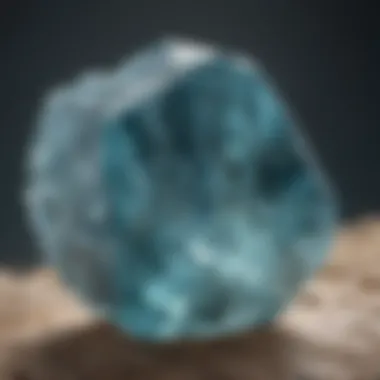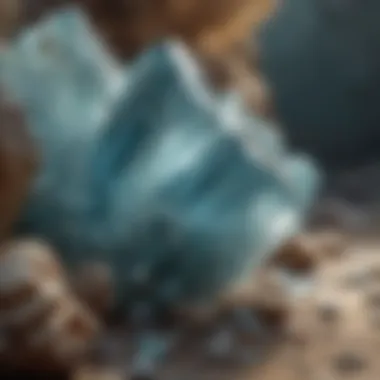Exploring the Raw Aquamarine Stone: Insights and Values


Intro
Delving into the beauty and intricacies of raw aquamarine stones opens a door to a world where geology meets artistry. This remarkable mineral, celebrated not just for its stunning color but also for its unique formation processes, invites collectors and enthusiasts alike to explore its many dimensions. Aquamarine, often characterized by its breathtaking shades of blue and green, is more than just a gem; it embodies centuries of environmental history. As we journey through this guide, we will dissect the characteristics of raw aquamarine, understand its value in the collection sphere, and provide insightful tips on preserving these prized possessions.
Rock and Fossil Identification
Types of Rocks
When it comes to identifying rocks, particularly those including fascinating gems like aquamarine, it's essential to be aware of the different types. Aquamarine is classified under the beryl family, which encompasses various minerals that are often formed in igneous environments. This type of rock, known as granite, is rich in quartz and feldspar, providing a sturdy backdrop for the crystalline beauty of aquamarine.
Characteristics to Look For
Identifying raw aquamarine is crucial for collectors. Here are some key characteristics:
- Color: Ranging from pale blue to deep greenish-blue.
- Clarity: Generally, aquamarine is more transparent compared to other beryl varieties.
- Hardness: With a rating of 7.5 to 8 on the Mohs scale, it’s quite durable.
- Crystal structure: Look for hexagonal prisms that can be indicative of aquamarine.
Tools for Identification
To effectively identify aquamarine and other minerals, consider these tools:
- Hand lens: Helps in examining the clarity and inclusions.
- Gem tester: To examine the hardness and other physical properties.
- Reference guide: Always handy for comparison and to validate discoveries.
Collecting Tips and Techniques
Best Practices for Collecting
To optimize the collection of aquamarine, keep in mind:
- Research: Understand the regions known for aquamarine deposits, like Brazil and Afghanistan.
- Respect laws: Ensure you're collecting in compliance with local regulations. Illegal collecting can lead to hefty fines.
Locating Prime Collecting Sites
Prime aquamarine finds can often occur in:
- Riverbeds: Erosion can surface hidden gems.
- Quarries: These locations often yield significant rock samples, but remember to seek permission before venturing in.
How to Safely Extract Specimens
When extracting raw stones, do it with care:
- Utilize appropriate digging tools to avoid damaging the crystal.
- Always wear gloves to protect against sharp edges.
Preservation and Display
Techniques for Preserving Rocks and Fossils
Once you have your aquamarine, preserving it is key:
- Avoid direct sunlight: Prolonged exposure can fade the color.
- Store in a cool place: Climate control minimizes potential damage.
Proper Storage Methods


- Use soft cloths: Wrap your stones to prevent scratches.
- Dedicated shelves: Keeping them in a designated space out of reach helps preserve their beauty.
Creative Display Ideas
Showcasing aquamarine can be an art itself. Consider:
- Shadow boxes: These frame the stones and protect them from dust.
- Themed collections: Group with other minerals to provide context and visual appeal.
Geological Insights
Geological Formations and Processes
Understanding the formation of aquamarine enhances appreciation. Beryl minerals, including aquamarine, form within pegmatitic environments that are characterized by their coarse grain size. These deposits often include elements like lithium that are essential for the creation of aquamarine.
Historical Significance of Rocks and Fossils
Throughout history, aquamarine has captured the imagination. It was hailed in ancient times as a stone of sailors, believed to provide protection and ensure safe passage.
Notable Discoveries in the Field
Several important sites have yielded spectacular aquamarine specimens. Discoveries in the Minas Gerais region in Brazil have produced stones weighing up to 110 kilograms, making them some of the largest finds ever documented.
"The journey of a collector is as fascinating as the stones themselves; investing time in understanding not just the product but the process enriches the collecting experience."
In cursory reviews, the world of raw aquamarine extends beyond mere collection. It’s a convergence of science, history, and artistry - an elegant reminder of nature’s creativity that captivates collectors and onlookers alike. Armed with this knowledge, your endeavor into the realm of aquamarine stones can be both rewarding and enlightening.
Intro to Raw Aquamarine Stone
When it comes to the world of gemstones, aquamarine stands out, not only for its beauty but also for its mysterious charm. This section lays the groundwork for understanding why delving into raw aquamarine stone is of crucial importance. The variety of characteristics, its geological aspects, and the role it plays in both collectors' hearts and the market cannot be underestimated. For rock and fossil collectors, knowing the nitty-gritty about aquamarine can enhance both the passion for collecting and the knowledge of what makes each specimen unique.
Defining Aquamarine
Aquamarine, a member of the beryl family, is famed for its stunning blue to blue-green hues. This particular stone has a composition of beryllium aluminum silicate, giving it a distinctive crystalline structure. One might say it's like the ocean captured in crystal form, offering a window into nature's palette. With the name derived from the Latin phrase meaning "water of the sea," aquamarine evokes images of clear skies and tranquil waters. Most notably, this gemstone can range from pale blue to deep azure, prompting a lot of debate about which shades are the most desirable among collectors. Its aesthetic appeal is not just skin deep; it also possesses certain physical properties that make it intriguing for exploration.
Historical Significance
The allure of aquamarine extends deep into history. Ancient sailors prized this stone as a talisman, believing it would keep them safe on turbulent waters. It’s often associated with myths and legends, particularly in Roman and Greek cultures, where it was believed to be a gift from mermaids, symbolizing love and protection. The stone was adored by royalty and often incorporated into crowns and jewelry, which further heightened its admiration. Collectors today value aquamarine not just as a beautiful stone, but also as a piece of history that carries stories from ancient civilizations. The ties to tradition and culture lend depth to its beauty, making it not merely an object to possess, but a link to the past.
"Aquamarine is not just a stone; it embodies the whispers of the ocean and the stories of the ancients."
Understanding these facets of aquamarine gives collectors a broader perspective of what they hold in their hands. As we move forward in this article, we'll explore the geological foundation, physical properties, and the ever-evolving landscape of aquamarine collecting, all while keeping the stone's heritage in mind.
Geological Formation
Geological formation serves as the foundation for understanding raw aquamarine stone. The complexities of how this mineral comes into being are crucial, providing insights not only into its physical properties but also its value and rarity in the collector's market. Understanding geological formation allows collectors to appreciate the unique characteristics of aquamarine and what influences its qualities, such as color and clarity.
Origin of Aquamarine
Aquamarine is part of the beryl family, which includes other gemstones like emerald and morganite. The origin of aquamarine can be traced back to beryl minerals that are composed of beryllium aluminum silicate (Be3Al2(SiO3)6). These minerals form under specific geological conditions, typically during the cooling of magma or via hydrothermal processes in igneous or metamorphic rock formations. This means that aquamarine is often found in environments where there is significant heat and pressure over long periods.
One significant aspect of its origin is the influence of trace minerals within the host rock. Elements such as iron give aquamarine its stunning blue to greenish-blue hues. The more iron present, the deeper the blue, which greatly impacts its desirability among collectors.


In simple terms, aquamarine is formed through a combination of heat, pressure, and the right ingredients. It’s like baking a cake — you need the right recipe and conditions to produce a delectable final product.
Mining Locations
Mining locations are another key factor in the availability and value of aquamarine stones. The most prominent aquamarine mines span the globe but are particularly concentrated in areas like Brazil, where some of the world’s largest aquamarine crystals have been discovered. Other notable mining locations include:
- Colombia: Known primarily for emeralds, Colombia also yields higher quality aquamarine.
- Nigeria: Nigerian aquamarine is often sought after for its distinct vibrancy.
- Afghanistan: This region has a long history of producing aquamarine, often found in granitic rocks.
- Madagascar: It has emerged as a reputable source of high-quality aquamarine tones.
When exploring mining locations, collectors should keep in mind that ethical sourcing and environmental impact are growing concerns in the gem industry. Collecting aquamarine from illegal or irresponsible mines can lead to significant ethical dilemmas. As the demand for aquamarine increases, knowing where to source responsibly is paramount.
"In the world of gem collecting, knowledge is power. Understanding where your aquamarine comes from not only enriches your collection but also aligns with ethical practices in the industry."
A deeper comprehension of geological formation, including the origin and mining locations of aquamarine, enriches one’s appreciation of this captivating mineral, while simultaneously providing sound guidance for collectors navigating the dynamic market.
Physical Properties
The physical properties of raw aquamarine stones play a pivotal role in determining not only their aesthetic appeal but also their value in the collecting community. Understanding these properties allows both seasoned collectors and newcomers to make informed decisions when evaluating potential purchases. The unique characteristics of aquamarine contribute significantly to its allure, acting as both a guide for authenticating specimens and a benchmark for quality assessment.
Color Variations
Aquamarine is renowned for its stunning array of color hues, ranging from delicate light blues to deeper, more saturated tones. These colors stem from the presence of iron within the crystal structure, which influences its overall appearance. A pure aquamarine often displays a light, icy blue tone that can be breathtakingly beautiful. Interestingly, the color may shift depending on the light environment, appearing to change shades when viewed under different lighting conditions.
Collectors often seek stones with vibrant and vivid colors. The deeper the blue, the more valuable the stone can be. The most sought-after aquamarines exhibit crisp clarity and rich saturation. However, lighter shades can still hold great appeal, especially those with a hint of green, which evoke the image of tranquil waters. As such, understanding color variations can aid in defining preferences and guiding purchase choices, ensuring collectors are selecting stones that resonate with their aesthetic vision.
Transparency and Clarity
Transparency is another key attribute of raw aquamarine. Superior specimens display clear, unblemished surfaces with minimal inclusions, allowing light to radiate through the stone with grace. The allure of aquamarine isn't merely its hue; clarity significantly impacts its brilliance and is sometimes deemed even more important than color by collectors.
When evaluating transparency, collectors should look for stones that allow for light to pass freely without distortion. This can make a world of difference in the aesthetic appeal of the piece. High-quality aquamarine stones are often eye clean, meaning they are free from inclusions visible to the naked eye.
When examining transparency and clarity, keep in mind:
- Natural Inclusions: Some collectors find beauty in natural inclusions as they signify authenticity and a unique story behind each stone.
- Cut and Shape: The way a stone is cut can affect how light interacts with it, enhancing or detracting from its natural clarity.
Hardness and Durability
Aquamarine scores a 7.5 to 8 on the Mohs scale of hardness, placing it among the tougher gemstones. This level of durability makes aquamarine a practical choice for various forms of jewelry and collectibles, resistant to scratching and general wear. However, it's essential to note that while aquamarine is resilient, it still requires care to maintain its surface integrity and luster over time.
Collectors should be mindful of the following when it comes to hardness and durability:
- Impact Protection: Though tough, it is wise to protect aquamarine stones from hard impacts that could lead to chipping.
- Regular Cleaning: Keeping the stone clean can enhance its appearance and longevity. A gentle wash with soap and water will do wonders.
In summary, the physical properties of aquamarine—its colors, transparency, clarity, and durability—are vital to understanding its appeal in the collector's market. Each of these characteristics weaves a rich narrative of authenticity and value, helping enthusiasts cultivate a thoughtful and informed collection.
"Understanding the intricate details of a gemstone not only enhances appreciation but also sharpens one's ability to make informed decisions in collecting."
Collecting Aquamarine
Collecting aquamarine is not just a hobby; it's a pursuit steeped in history, geology, and a unique appreciation for this stunning stone. For enthusiasts and collectors alike, the excitement lies in understanding what makes aquamarine distinct in terms of its formation, beauty, and the stories behind each piece. Notably, aquamarine exudes a calm, tranquil aura reminiscent of the sea, and it possesses qualities that charm both seasoned collectors and newcomers to the field.
Finding Authentic Specimens


When it comes to aquamarine, finding authentic specimens can feel like hunting for a needle in a haystack. However, knowing what to look for can significantly enhance your chances. One key to identification is understanding the origins; aquamarine is primarily sourced from places like Brazil, Madagascar, and Nigeria among others. Each location yields variations in color saturation and clarity.
To avoid getting sold a counterfeit or lesser quality piece, keep these elements in mind:
- Color: Authentic aquamarine typically showcases shades ranging from pale blue to deep blue-green. A vibrant color generally indicates a higher quality specimen.
- Clarity: The presence of bubbles or inclusions might indicate it’s not genuine; the clearer the stone, the more valuable it is.
- Certification: Trusted sources often provide certification of authenticity. Certificates can lend enormous credibility to a purchase, ensuring the collector knows they are getting a genuine piece.
Don’t shy away from connecting with local mineral shows, gem fairs, or online platforms like Reddit or dedicated Facebook groups. Engaging with other collectors can provide insight into where to find authentic stones and tips on making good purchases.
Evaluating Quality and Value
Once you have a potential aquamarine specimen in hand, evaluating its quality and value becomes paramount. Different factors come into play, and being knowledgeable can make a substantial difference in what you're willing to pay.
Here are some criteria to consider when assessing an aquamarine stone:
- Carat Weight: Like many gemstones, larger carat weights often equate to higher value, assuming other quality factors are met.
- Color Depth: Deeper, more saturated colors tend to fetch higher prices. Light blue may be appealing, but vivid blue is what most collectors covet and are willing to pay more for.
- Clarity and Quality of Cut: A well-cut stone can enhance the light play, making it more attractive. Look for stones that have minimal inclusions.
- Rarity of the Source: Different mines produce distinct colors. For example, aquamarine from certain regions can be considered rare and can therefore be priced higher.
"A thorough understanding of these elements not only aids collectors in acquiring quality stones but also reinforces their appreciation of aquamarine's value."
In addition, educating yourself on market trends can balance emotion in price negotiation. Be mindful, though; an aquamarine that catches your eye may be worth the splurge, but it's always good to be cautious and informed as one navigates through the world of collecting.
Identification Techniques
Identifying raw aquamarine stones accurately is crucial for collectors, whether they are just starting out or have years of experience. Knowing how to distinguish authentic stones from imitations or lower-quality materials can save both time and money, but it also adds to the appreciation of this stunning mineral. Understanding the characteristics that set aquamarine apart empowers collectors to make informed choices.
Visual Inspection
When it comes to the first line of defense in identifying aquamarine, a keen eye and careful observation can work wonders. Here are some points to consider during a visual inspection:
- Color: Genuine aquamarine is known for its striking blue to green-blue hues, often reminiscent of seawater. However, there can also be subtle variations in tone. Watch out for colors that are too vibrant, which might suggest that a stone has been enhanced or treated.
- Clarity: A quality aquamarine will exhibit a degree of translucence, allowing light to pass through. Inspect the stone for inclusions or bubbles which could hint at a synthetic or treated origin.
- Shape: While aquamarines are often cut into standard shapes such as ovals or rounds, raw stones have unique formations. Collectors should familiarize themselves with the typical raw shapes of aquamarine, which can aid in distinguishing it from other minerals.
- Polish and Shine: Natural raw aquamarine will have a more matte finish, whereas stones that are overly polished may indicate treatment or enhancement. An authentic look often possesses a more earthy allure.
With a visual inspection, it’s important to remember that first impressions can be tricky. Just because a stone looks authentic doesn’t mean it is—always delve deeper with tools when necessary.
Use of Gemological Tools
Visual inspection only scratches the surface when it comes to identifying aquamarines accurately. Gemological tools can provide deeper insights and ensure that you are dealing with the real McCoy. Here’s a snapshot of essential tools and their applications:
- Loupe or Microscope: These magnifying tools allow collectors to spot fine details. Under magnification, you can look for the distinct crystal structure or any potential flaws that might indicate a fake.
- Refractometer: This handy tool helps determine the refractive index of a stone. Aquamarine typically falls within a specific range, and using a refractometer can confirm its legitimacy.
- Spectroscope: This device analyzes light wavelengths. Each gemstone will have a unique absorption spectrum, making it easier to distinguish aquamarine from similar-looking stones.
- Hardness Tester: Aquamarine ranks a 7.5 to 8 on the Mohs scale. Testing its hardness can verify its authenticity, as many look-alikes lack this durability.
"Gemological tools are like a magnifying glass for your expertise - they not only reveal what’s beneath the surface but also reinforce your confidence as a collector."
Caring for Raw Aquamarine Stones
Caring for raw aquamarine stones is not just a chore; it's an essential practice that can preserve both their beauty and value. These stones, while striking and alluring, can easily lose their luster if neglected. Proper care can avoid scratches, dirt accumulation, and even potential damage from harsh environments. Whether you’re a seasoned collector or just starting, understanding how to maintain your aquamarine is pivotal.
Cleaning Methods
The first step in maintaining raw aquamarine is to clean them regularly. Keeping them free of dirt and oils helps maintain their natural transparency and brilliance. Here are a few recommended cleaning methods:
- Gentle Soap Solution: Mix warm water with a few drops of mild dish soap. Use a soft cloth or a gentle brush to clean the surface without scratching it.
- Distilled Water Rinse: After using soap, a rinse with distilled water can remove any residue, preventing mineral deposits that can dull the stone's surface.
- Ultrasonic Cleaners: While effective, it's crucial to ensure that your specific aquamarine is suited for ultrasonic cleaning, as some stones may be more fragile.
Tip: Always avoid harsh chemicals or abrasive scrubbers that can mar the surface of the stone.
Cleaning steps:
- Create a soap solution.
- Gently scrub with a soft cloth.
- Rinse with distilled water.
- Air dry completely.







